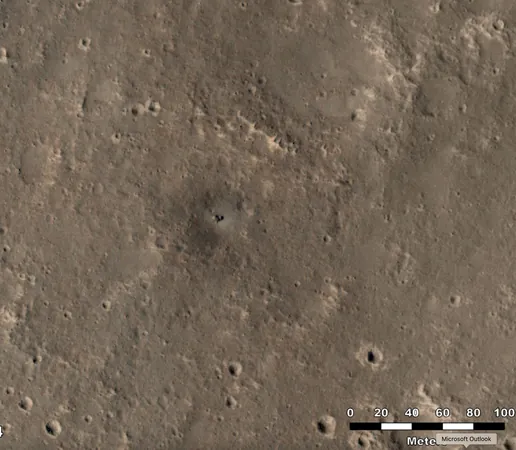
NASA's Mars Reconnaissance Orbiter Discovers Dusty Fate of Retired InSight Lander
2024-12-16
Author: Emma
NASA's Mars Reconnaissance Orbiter (MRO) Reveals Dust Accumulation on InSight Lander
NASA's Mars Reconnaissance Orbiter (MRO) has recently provided a stunning new image of the agency's retired InSight lander, revealing the significant dust accumulation on its solar panels. Captured on October 23, this high-resolution image from MRO's High-Resolution Imaging Science Experiment (HiRISE) camera showcases the InSight lander, which has taken on the same reddish-brown hue as its Martian surroundings.
InSight's Historic Mission
InSight made its historic landing on Mars in November 2018. It was pivotal in detecting marsquakes, leading to groundbreaking insights into the Red Planet’s interior structure, including its crust, mantle, and core. Over its four-year mission, NASA's Jet Propulsion Laboratory (JPL) utilized images from both InSight and the MRO to assess the dust's impact on the lander’s power generation capabilities due to the accumulation of dust on its solar panels.
End of Communication
After its operational phase concluded in December 2022, InSight went silent as it depleted its power reserves. Although a dedicated team of engineers continued to listen for any return signals, hopeful that Martian winds might clear some dust and rejuvenate its solar batteries, no signals have been received for over two years. Consequently, NASA plans to officially cease attempts to contact InSight at the end of this calendar year.
Scientific Importance of Dust Monitoring
The recent HiRISE image serves as both a farewell tribute to InSight and a tool for scientists to observe changes at its landing site over time. “Even though we are no longer in contact with InSight, it continues to enlighten us about Mars,” commented Ingrid Daubar, a team member from Brown University. “Monitoring dust accumulation and removal processes provides invaluable information about Martian winds, dust cycles, and the greater mechanisms that shape this enigmatic planet.”
The Role of Dust on Mars
Dust, an omnipresent force on Mars, significantly influences the atmosphere and surface features. This knowledge is not only vital for scientific understanding but also for preparing future solar-powered missions to avoid potential dust-related challenges. During its active period, InSight’s data on dust devils—whirling wind phenomena—helped scientists understand how these formations behave with seasonal changes, demonstrating diminished activity in winter and increased occurrences in summer.
Geological Insights from InSight
Furthermore, the study of meteoroid impacts reveals the geological history of Mars, where the density of craters around a region indicates surface age. Unlike Earth, where tectonic activity continually renews the surface, dust accumulation rates on Mars can be utilized to ascertain the age of craters based on how quickly they are obscured over time.









 Brasil (PT)
Brasil (PT)
 Canada (EN)
Canada (EN)
 Chile (ES)
Chile (ES)
 España (ES)
España (ES)
 France (FR)
France (FR)
 Hong Kong (EN)
Hong Kong (EN)
 Italia (IT)
Italia (IT)
 日本 (JA)
日本 (JA)
 Magyarország (HU)
Magyarország (HU)
 Norge (NO)
Norge (NO)
 Polska (PL)
Polska (PL)
 Schweiz (DE)
Schweiz (DE)
 Singapore (EN)
Singapore (EN)
 Sverige (SV)
Sverige (SV)
 Suomi (FI)
Suomi (FI)
 Türkiye (TR)
Türkiye (TR)